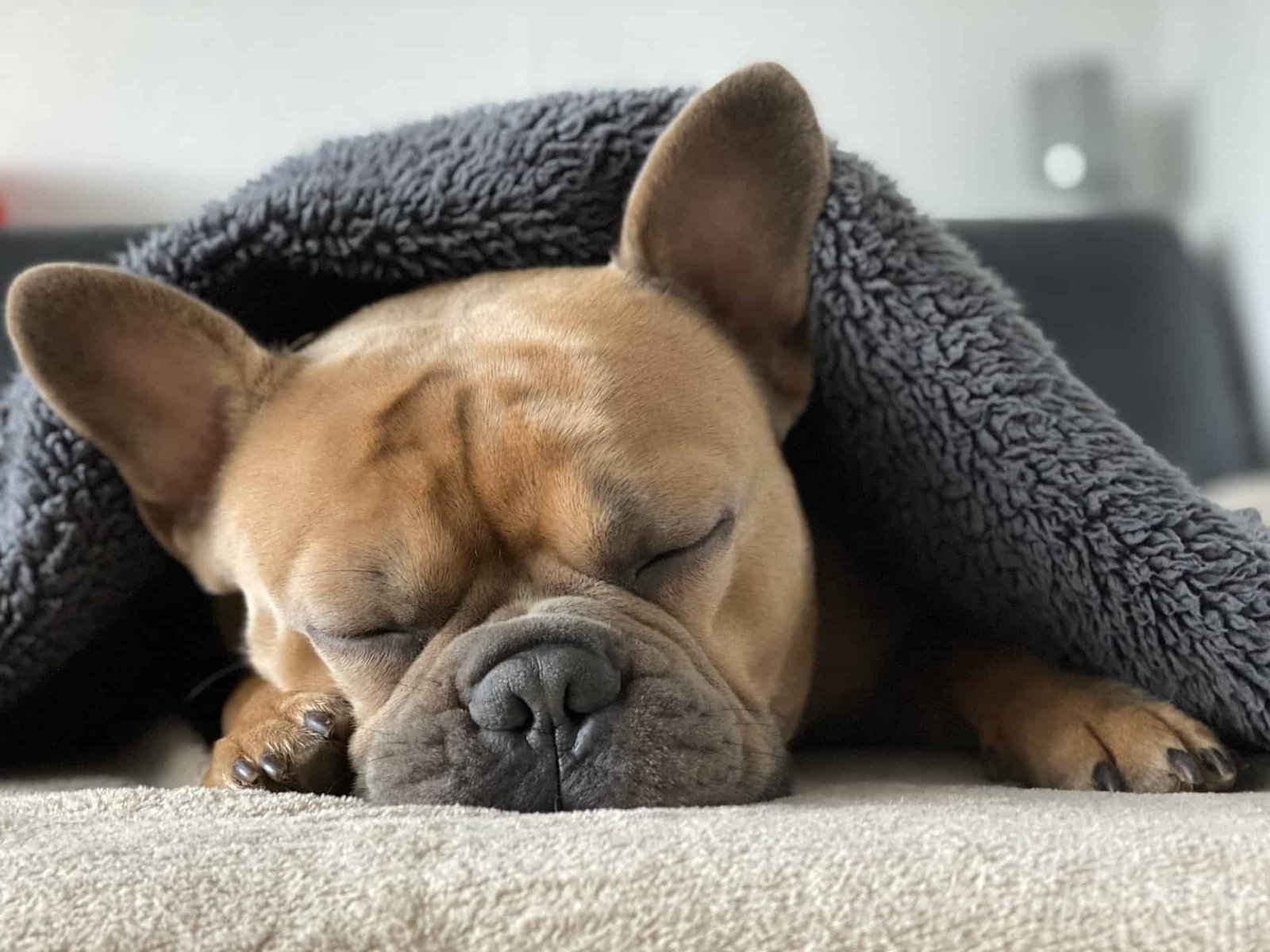Lots of dogs have a favorite blanket.There are plenty of reasons why even grown dogs are attracted to having a special blanket for resting and sleeping. Humans are also fans of having a good blanket of their own for relaxation, and like their human companions, dogs are no exception ot the rule!
Below you’ll find a list of some of the many reasons why blankets are good for dogs. Some of the reasons are practical reasons like physical comfort, while others are more psychological. Read on to learn more about blankets, their effect on canine behavior, and which blankets are best for your dog.
Blankets Help Keep Dogs Warm
A major reason that blankets are good for dogs is that they can help keep dogs warm, just like they help keep people warm. Dogs generally prefer to be warm, which is one reason that they tend to bury down in their owner’s blankets on the bed when they’re allowed to sleep on it.
Some dogs are more susceptible to cold temperatures than others due to their extremely short hair. These are breeds of dogs that evolved in the hotter regions of the world that have been designed to endure extreme high temperatures. But when these breeds are kept in colder parts of the world, they tend to be uncomfortably cold without a blanket to warm them.
Here are a few breeds of dog that are susceptible to getting cold without a blanket (Source: Treat Your Dog):
- Mexican Hairless: The Mexican hairless dog, also known as the Xoloitzcuinthe or Xolo, is one of the shorthaired dog breeds developed in temperatures over a hundred degrees. These dogs are prone to shivering and discomfort without a warm blanket.
- Chihuahua: Chihuahuas are another Mexican breed like the Xolo, but they actually have a short coat of hair unlike the bald Mexican hairless. However, this short hair is not enough to keep Chihuahuas warm, especially with their small body size. Getting Chihuhuas a good blanket can go a long way towards keeping them warm.
- Chinese Pug: Chinese pugs are a breed of dog originally bred as an indoor watch dog for Chinese royalty, and these prissy little dogs prefer to stay out of inclement weather and under a warm blanket on the couch.
- Greyhound: Even though greyhounds are a larger breed, their thin frames and sparse layer of fur mean that they are prone to getting cold even indoors. They’re also designed to conserve energy when they’re not running, which means they tend to run cold. Providing them with a dog blanket can help keep them cozy even on the coldest winter night.
While these breeds are especially uncomfortable in cold temperatures, even longhaired dogs and Nordic breeds like cuddling under a blanket to go to bed for the night.
Blankets Help Simulate Dog Littermates

Many people know a dog that enjoys being wrapped up like a burrito or burrowing into the blankets on the bed at night, and there are real psychological reasons behind this phenomenon in dogs. For many dogs, swaddling in blankets can help recreate the feelings of tight closeness and security that dogs feel when they are tucked in among their littermates as babies.
This tendency for blankets to bring up feelings of infancy in dogs can also be seen in another dog habit related to their blankets—sucking. Dogs that suck on blankets are simulating behaviors that they would be performing as puppies on their mother.
In many cases, like with human children, blanket sucking is a self-soothing habit, like a child sucking their thumb. (Source: Barkspot) But blanket sucking can also be an indication of a few situations that may have occurred during a dog’s puppyhood, such as:
- The puppy was removed from their mother and littermates too early
- The puppy’s mother did not allow her puppies to suckle for comfort, or weaned them very early
- The puppy was bottle-raised by humans without a canine mother
In most cases, blanket sucking and swaddling for dogs has no ill effect and can make dogs feel more comfortable, just like when older children are sometimes comforted by being treated like babies. This makes blankets a great coping mechanism for dogs that are prone to emotional sensitivity or anxiety.
Blankets Help Ease Separation Anxiety in Dogs
Just like dog blankets can help simulate littermates and a dog’s mother to soothe them, blankets can also be used to help ease a dog’s separation anxiety from their owner.
One of the first major challenges that many new dog owners run into is their dog not wanting to be separated from them at night while sleeping, especially if the dog is a puppy alone on its own away from its littermates for the first time. Since it isn’t a good idea to get a dog used to sleeping in or on the bed, crate training is usually the best option for training a new dog or puppy.
However, being confined to a crate at night can create separation anxiety. Blankets are one way that owners can help alleviate this separation anxiety and help their dog sleep better in the crate. The best way for an owner to do this is to get a blanket and rub it on their body or their dirty laundry, and then putting the blanket back in the crate.
Overnight or during the day when their owner is at work, leaving a blanket scented with their owner in the crate with them can help them from becoming panicked or lonely when they’re left alone. Since dogs are primarily scent-based creatures, this scented reminder provides a great sensory relief when they feel like they’ve been abandoned.
Here are some other accessories that can be added to blankets to help them ease separation anxiety:
- Snuggle Puppy: The Snuggle Puppy is a small stuffed animal designed to simulate the realistic heartbeat of a dog’s littermates. When this device is wrapped in the dog’s blanket in their crate overnight or throughout the day, it can provide a point of comfort for the dog.
- Outward Hound Dog Puzzle: Dog puzzles are another sensory-based object that can be placed in a crate along with a dog blanket to help keep the dog’s mind simulated while it is left alone. Giving the dog something to do while it lies on its blanket helps relieve boredom and stress.
Blankets Can Soften the Bottom of Dog Crates

While most veterinarians recommend crate training a new dog or puppy before giving them free rein of the house to verify housebreaking and keep them from destroying furniture or other items in their owner’s absence, crates can be uncomfortable.
Made of hard metal and plastic, no crate looks that appealing for dogs to spend extended amounts of time in. Laying on this hard plastic for several hours can lead to hard calluses on the dog’s elbows or chest. (Source: I Heart Dogs) But with owners who work, this is the reality for many dogs until they can be trusted loose around the house.
Blankets are the perfect solution to a hard crate bottom since they can be used as a padding beneath the dog’s bed in their crate. It’s important that a sturdy blanket is used so the dog isn’t tempted to tear it into tiny pieces during the day.
Blankets Can Help Protect Furniture From Dogs
Blankets are a comfort for many dogs, but they serve a practical purpose for dog owners too. For owners who want their dogs to be able to safely sit on the furniture without damaging it or ride in the car without getting hair everywhere, blankets can help provide protection for furniture and other surfaces against the following:
- Dog nails: Even with their nails trimmed, dogs can accidentally scratch up chairs or couches when they get the zoomies and start jumping around on the furniture. Lying blankets on top of the furniture can help keep dog nails from tearing up leather or other expensive fabrics.
- Dog hair: There’s nothing worse than dog hair when it has a chance to work its way into couch cushions and rugs, but laying down dog blankets in the areas where your dog likes to rest most often can help keep down excess hair. Using blankets as a protective layer in these areas where dogs are most likely to lay down prevents hair from working into carpets and furniture.
- Dog teeth: Some dogs have a tendency to playfully gnaw furniture, especially as they’re growing into adolescence. Providing young dogs will plenty of alternative things to try their teeth on during play, including blankets, can keep them from using their teeth on household objects they’re not supposed to be chewing on.
- Dog urine/feces: Puppies are prone to having housebreaking accidents before they’re fully trained, and elderly dogs likewise often develop incontinence issues as they age and lose mobility. Strategically placing blankets where puppies and elderly dogs rest can help prevent pet accidents on the carpet or bed since they’re most likely to have an accident right after waking.
Dogs enjoy blankets as a comfort object, but having plenty of blankets around is also a practical solution for dog damage to furniture and other items in the home. Adding a stain guard like Scotchgard can also help prevent dog-related stains to furniture and blankets too.
Dog Blankets Help Dogs Sleep Better

Dogs are like people in many ways, and one of the ways that they’re similar to people is that having a blanket of their own helps them sleep better.
As with any mammal, getting plenty of good sleep is vital for dogs, especially when they’re still growing and developing. Dogs sleep an average of nine to fourteen hours a day, which is a lot compared to humans (who typically get six to eight hours). (Source: Sleep.org) Puppies and senior dogs require more sleep than adult dogs.
Dog blankets help make dogs more comfortable while they’re sleeping, but they also help simulate some of a dog’s other natural instincts such as nesting and marking their territory with their scent. Behavioral enrichment is just as important for dogs as it is for wild zoo animals in helping to maintain their mental and emotional health. (Source: Untamed Science)
People may not often consider the quality of their dog’s sleep even if they see them sleeping every day. But just like humans, dogs benefit mentally and physically from sleeping with comfort items that help make them feel safe.
Blankets Help Reduce Stress for Dogs
The same traits that make blankets good for dogs when it comes to quality sleep are also great at helping dogs reduce anxiety and stress.
Some breeds of dogs are more prone to high levels of anxiety than others due to a generally high-strung nature, such as border collies or poodles. Other individual dogs such as rescues may have a background history of trauma or neglect that makes them more prone to anxiety, especially during periods of separation.
Here are some of the ways that blankets help reduce stress in dogs:
- Being swaddled in blankets decreases levels of cortisol, a chemical in the brain that is created in reaction to stress
- Blankets help increase levels of melatonin, a chemical in the brain that makes the body drowsy and relaxed
For dogs that are especailly prone to stress, spraying their blanket with anti-stress pheremones can help encourage relaxation. These sprays last up to six hours and can help decrease dog stress by signaling natural relaxation cues in their bodies.
These are a few other items that can be used alongside blankets to help reduce stress in dogs:
- Dog calming chews: Dog calming chews made with hemp and other natural ingredients can help reduce hyperactivity in dogs and can keep their anxiety levels low during periods of shock or stress. Calming chews are especially good paired with a security blanket on long travel trips that might over-excite a dog.
- Thunder shirts:Thunder shirts are a type of weighted shirt that is put on a dog to help simulate a deep pressure like swaddling that relieves physical anxiety. Thunder shirts combined with a security blanket can be a great way for dogs who are afraid of storms to get some relief.
What Is the Best Material for a Dog Blanket?
Blankets are made out of many materials, and some materials are better suited as dog blankets than others. Materials that should generally be avoided are materials that can come apart easily if the dog decides to chew on them, or blankets that are easily unraveled.
Fleece is generally considered the best material for dog blankets. This is for several reasons:
- Durability: Unlike some blanket materials, fleece is extremely durable and its dense nature makes it difficult for dogs to rip it apart. Even for dogs that tend to pick at their blankets or suck on them, fleece can take a lot of wear without becoming tattered.
- Softness: Fleece is one of the softest materials used in household blankets. This makes it the perfect blanket material for lining the bottom of a dog crate or just adding a comfy protective layer to the couch.
- Price: Unlike other materials, fleece or its artificial equivalent are generally inexpensive, which means that even if the blanket becomes stained or damaged, it can be thrown out or cut into rags and replaced without too much trouble. The cheap price of fleece blankets means that many blankets can be kept on hand too for layering or using in different areas of the house.
- Cleaning: Fleece is easily washed in the washing machine and when it has been protected with a stain guard, it doesn’t stain easily either. Because fleece doesn’t require any special washing instructions, it can be tossed in with any old load of laundry without being damaged.
There are other materials that are commonly used in blankets such as quilting cotton and suede, but these materials tend to be more easily damaged and less durable against the hair, urine, and other things left behind by dogs. When looking for a dog blanket, here are some things to keep in mind when considering the material:
- How easy is the material to wash?
- Can the blanket be ripped apart for the dog to reach padding on the inside?
- Does the blanket come with a washable cover?
Many people share their own blankets with their canine companions regardless of the material, and if your dog is well-behaved, this can be a good setup. But sharing blankets with your dog means keeping them on a flea and tick preventative if you don’t want to end up with pests in your blankets, too.
Blankets Are Practical and Comfortable for Dogs
Unlike dog beds, which can be somewhat difficult to clean if they don’t come with a removable cover, dog blankets are easy to toss in the washing machine and place around the house to keep it dog-friendly. Blankets are great for soothing dogs and also protecting furniture from them, which makes keeping plenty on hand a useful resource for dogs and humans alike.
Content Disclaimer
The information contained above is provided for information purposes only. The contents of this Blog article are not intended to amount to advice, and you should not rely on any of the contents of this Blog article. Professional advice should be obtained before taking or refraining from taking any action as a result of the contents of this Blog article. VesteForPets.com disclaims all liability and responsibility arising from any reliance placed on any of the contents of this Blog article.
Copyright Notice
These works are protected by copyright laws and treaties around the world. We grant to you a worldwide, non-exclusive, royalty-free, revocable licence to view these works, to copy and store these works and to print pages of these works for your own personal and non-commercial use. You may not reproduce in any format any part of the works without our prior written consent.
Copyright © 2022 – 2024 Veste For Pets







